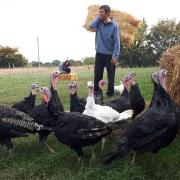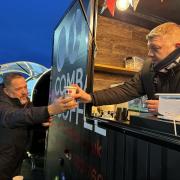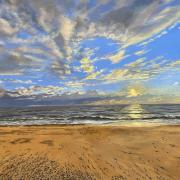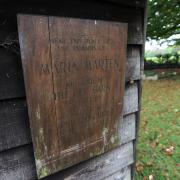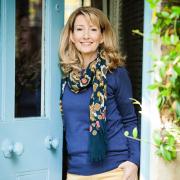By Naomi Gornall Meet the artist, the nature lover and the distiller, who have all been inspired by the county’s coast to follow their vision and create something with Suffolk at the heart of it, from jeweller to gin to wild experiences.
It’s hard not to feel inspired by the beautiful Suffolk coast; sparsely populated beaches — some sandy, some shingle — wild waves, rugged cliff edges, and large skies. For some of us, a yearning to see the sea and soak up the coastal air is satisfied by regular trips to the coast. But for others this pull to the county’s shoreline has become part of their livelihood.
From artists to authors, Suffolk is no stranger to being a muse. But it's not just creative types who are captivated by its charm. The natural products and materials grown here have influenced many to start their own businesses. There are also environmentalists and conservationists who help protect the rich array of flora and fauna near the coastline.

At home with nature
Matt Wilson, the National Trust’s countryside manager for Suffolk and Essex, admits his job is pretty amazing. His patch stretches from Dunwich Heath in the north of the county to Northey Island in the Blackwater Estuary in Essex, which presents a variety of different challenges and landscapes. Among the sites he oversees in Suffolk is Orford Ness, a former military testing site and now an internationally significant nature reserve.
'I had never been to Orford Ness before I started this job,' he says. 'It is the most bizarre place I have ever worked, in a truly amazing way. One of reasons that I joined the trust was to work in these sorts of places. Being able to come to work on a boat, on a dark morning, and watch the wind sweep across the shingle as the clouds roll in, is incredible.'
Matt, who joined the trust last October, manages ranger teams, day-to-day. He is also involved in monitoring and surveying, vegetative management, woodland work and leading walks and tours for the public. He remains in awe of the abundance of wildlife and plant life that exists at Orford Ness.
'I grew up in Essex and used to see the odd brown hare in the fields but I’ve never seen so many in my life as I do on the island. We get wildlife on this site that other reserves would be desperate for; nesting Marsh Harriers, Chinese water deer, avocets.' As he speaks, looking out over the sea, a curious seal pops his head above the water. Matt smiles. 'Due to the limited access here, the wildlife are undisturbed so they can thrive,' he explains.
Orford Ness, which is 10 miles long and one mile wide, isn’t open to the public all the time and is only accessible by boat. During the summer months when visiting times increase, there are set paths to follow due to the risk of unexploded ordnance. This reminder of its military past can be seen throughout the Ness with various detritus scattered across the shingle, and abandoned concrete buildings — the iconic pagodas — forming an eerie image on the horizon. Nature has found a way around these man-made obstacles and seems to co-exist easily alongside them.
The site is home to 10 per cent of the country’s coastal vegetated shingle, one of the rarest habitats in Europe, which take hundreds of years to form and is created by natural tidal processes. The other coastal sites where Matt works are inspiring in other ways. 'There is so much at Dunwich — when the gorse is flowering, nightjar surveys, deer on the heath, glow worms, adders. I have always loved nature and I’m continuing to learn on the job.
'I also look after Pin Mill and have to manage the stag beetle population there, which is something I’ve never done before. One of the things I love about Suffolk is how much space there is for wildlife and for people to experience it. It’s such a dynamic and changing coastline.'

The spirit of the coast
Suffolk’s unique attributes also motivated Andrew Heald to create Fishers Gin seven years ago. The gin is infused with botanicals grown at his family farm in Snape and is made at his Aldeburgh distillery overlooking the ocean. Both Andrew and his distiller, Ben Bewley-Pope, plant the botanicals themselves and hand-pick them.
Andrew was working in the wine industry but as the gin market growing, he was keen to produce something that reflected Suffolk’s environment. 'The French believe that when you're drinking wine, each wine should reflect that land, not just the climate but everything, like the flora and fauna; they call it terroir. I’ve always loved this part of the world. I grew up in London but spent lot of time here as a child and my father’s family are originally from here. I wanted to create something that reflected this sense of place.'
Like many visitors to Aleburgh, Andrew initially assumed it was just a seaside town. But when he moved there, he discovered the estuary and marshes and was fascinated. 'I knew nothing about plants, so in the beginning a gardener helped me with the botanicals so we could create a gin that was more English and coastal. We grow half of the botanicals used in our gin at the family farm — coriander, angelica, wood avens.'
Thanks to Andrew’s links with brewer and distiller Adnams, through the wine world, he was able to make and bottle his gin at their Southwold factory. In 2019 Andrew began a project to create an Aldeburgh base for the product — its ‘spiritual home’, he says — and converted a beach house into an impressive tasting room and distillery, thought to be the closest to the sea in the country.
Lockdown in 2020 delayed the opening until July that year, but since then visitors have been flocking to gin tours and tastings. The seasonal tours include a botanical tea making experience, a short film with drone footage over the Alde estuary to show where the gin has come from, plus a chance to see the 400-litre copper still in action. Andrew’s business has become part of the community as he has collaborated with local restaurants and partnered Pinneys of Orford, smoked seafood specialists, in smoking the botanicals for a smoked gin.
'The ambition is that Fishers appeals to people along the whole of the coast. We’d like to create new expressions of the coast but keep it authentic.'

The art of wellbeing
Artist Jo Barrett utilises the coast’s natural products in a different way, creating jewellery from sea glass and other coastal-themed art and homewares.
Originally from Essex, Jo always loved the beach and enjoyed many water sports. In 2018, however, her health began to deteriorate, and her water-based hobbies became restricted. During the pandemic, she had to shield and gave up work, but her yearning for the sea was undiminished. It was then that she began to make jewellery based on her love of the coast and eventually set up her own business called Sage and Seasalt.
'During lockdown, I was craving the coast; it was torture not being able to go to it. I found that I was able to escape by creating my beach inspired art. I had been collecting sea glass for over 30 years so I had a big collection to work from.'
Once Jo was able to return to her beloved coast, she tried a shallow paddle and found that the cold water helped her health condition. Since then, she tries to swim regularly, travelling from her home in Stowmarket to join like-minded wild swimmers at Shingle Street and Felixstowe.
Her favourite spots in the county are Covehithe and Southwold, but she loves to explore the whole of the UK’s coast, with her most recent trip being the Hebrides. 'I have a love of travelling and always try to bring a tiny bit back with me, like some sand, to use in my art.'
The Suffolk coast has inspired people in various forms for centuries and it will continue to do so. From Dunwich down to Felixstowe, this 50-mile stretch has featured in books, films, and songs. It is also home to some of the best food and drink producers, and nature filled landscapes and reserves. The wildness, uniqueness and beauty of the county is surely unmatched and will continue to ignite people’s imagination for many years to come.




